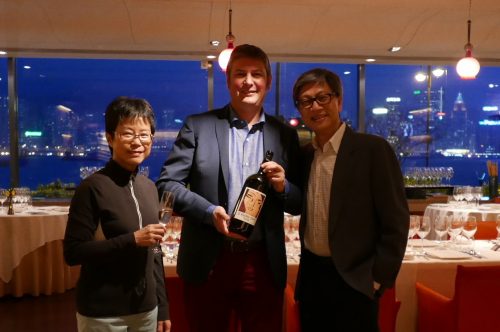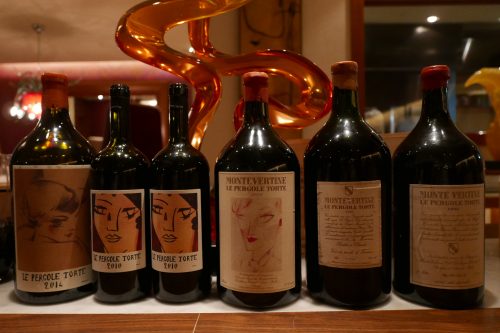Views: 26
生物動力曆法﹕2018 年 4 月 16 日下午 7 時開始 果
「女人頭」是有數的意大利膜拜酒,我們看看 Antonio Galloni 這番話便知道這尊神有多高:
There are many pedigreed wines in the world, but some rise above that level and move into the stratosphere of the truly iconic. Montevertine’s Le Pergole Torte is one of those wines because it weaves together so many strands of history and culture (2016 年 1 月)
這個莊幾乎像 Gaja 一樣,信衆有時候甚至忘了她來自何方(Chianti),也不知道她有些更可愛的兄弟姐妹。
繼 Monsanto 之後(VIPa-6 第 3 場 — 回歸 Chianti 之一:Monsanto),讓我們繼續今年重新開始的 Chianti 之旅。
從來就沒有神仙皇帝,只有天、地和人,希望這次活動能讓大家加深明白 Montevertine 和 Chianti。
與上次一樣,我加插了一款 Brunello,讓大家可以比較 Sangiovese 在兩個產區有什麽不同的表現。
透過 5 個不同年份,我們可以比較「女人頭」在冷、暖和經典年份有什麽表現。
是晚酒單如下:
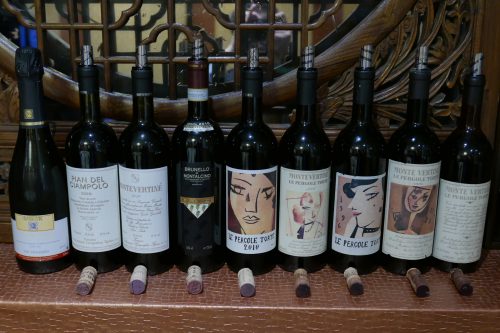
|
1. Montevertine, Pian Del Ciampolo, 2010 |
|
2. Montevertine, Montevertine, 2010 |
|
3. Montevertine, Le Pergole Torte, 2010 |
|
4. Le Chiuse, Brunello di Montalcino, 2010 |
|
5. Montevertine, Le Pergole Torte, 2000 |
|
6. Montevertine, Le Pergole Torte, 1996 |
|
7. Montevertine, Le Pergole Torte, 1985 |
|
8. Montevertine, Le Pergole Torte, 1980 |
1980 與 1985 在 21 小時前開瓶,其餘在 29 小時前開,多少個小時並沒有什麽玄機,只爲了遷就我前一天的活動。開瓶後拔塞作瓶醒。
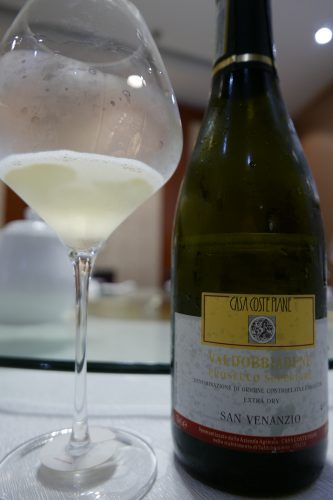 開場的 Casa Coste Piane, Prosecco Superiore San Venanzio 是用香檳方法釀製的 Prosecco,在酒瓶内作二度發酵。我先後試過酒莊的三款酒,這是果味最豐富的,有梨子和蘋果,酸度好,收結有綿長的礦物味。第二回合較平衡,或許根日會更複雜,多存放些時間也應該有幫助。
開場的 Casa Coste Piane, Prosecco Superiore San Venanzio 是用香檳方法釀製的 Prosecco,在酒瓶内作二度發酵。我先後試過酒莊的三款酒,這是果味最豐富的,有梨子和蘋果,酸度好,收結有綿長的礦物味。第二回合較平衡,或許根日會更複雜,多存放些時間也應該有幫助。
我們先看看 Montevertine 的葡萄園。今天他們種了 18 公頃,分佈在 6 個葡萄園:
Le Pergole Torte
planted in 1968, surface 2 hectares, exposed towards N-NE
Montevertine
planted between 1982 and partially replanted in 2008, surface 2.5 hectares, exposed towards SE-S;
Il Sodaccio
planted in 1972 and completely replanted in the year 2000, surface 1.5 hectares, exposed towards SE;
Il Casino
planted in 1999, surface 2 hectares, exposed towards S;
Selvole
planted in 1997, surface 3.5 hectares, exposed towards SE-S;
Pian del Ciampolo
planted in 2003, surface 1.5 hectares, exposed towards W-NW;
最早栽種的是 Le Pergole Torte,1981 年申請為 Chianti Classico 被 Consorzio 否決後,便改以餐酒(後來的 IGT)出現,當時是單一園所出,後來又有另一款 Il Sodaccio 的單一園。
從 1990 年代開始,以 Le Pergole Torte 爲名的酒款改爲精選版,從所有葡萄園中選最好的葡萄,而 Il Sodaccio 在 1990 年代末也因爲葡萄園染病而要重植,之後再沒有以單一園方式出現。
也就是說,酒莊剛開始時的酒款以葡萄園來區分(Burgundy 法),後來演變為今天產區通常的做法,就是按葡萄質量的高、中、低來分出三款,Le Pergole Torte 相當於 Chianti Classico Riserva,其次是 Montevertine 和 Pian del Ciampolo,我們姑且稱之爲 Bordeaux 分級法。
我們先試最基本的兩款。
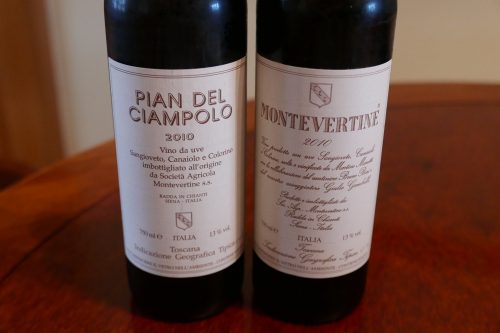 兩款酒的顔色都很淺,難得的是很開放而且非常好喝。
兩款酒的顔色都很淺,難得的是很開放而且非常好喝。
1. Montevertine, Pian Del Ciampolo, 2010 從早上已經噴發粉香,帶些草本,這時更香得驚人,厚度也增加了,略帶鹹的果味,有一絲絲的複雜度。
2. Montevertine, Montevertine, 2010 有些類似,但明顯地較濃,而且修飾得更好(polished),丹寧也更明顯。
兩者相比,Pian Del Ciampolo 較多草本,比較粗獷;Montevertine 則較多脂粉,比較細膩。
大家這時愛 Pian Del Ciampolo 更多,比數是 7:4。
第二回合的 1. Montevertine, Pian Del Ciampolo, 2010 完全敞開了,夾著香粉與森林、檀香味,通透無比,那種不靠修飾的天然美讓人驚艷;2. Montevertine, Montevertine, 2010 往深處發展,更香粉,濃妝得有幾分冶艷。
大家更倒向 1. Montevertine, Pian Del Ciampolo, 2010 了,差距擴大為 9:2。有朋友說 2. Montevertine, Montevertine, 2010 仍未開盡,説得在理。
接著由「女人頭」對 Le Chiuse。
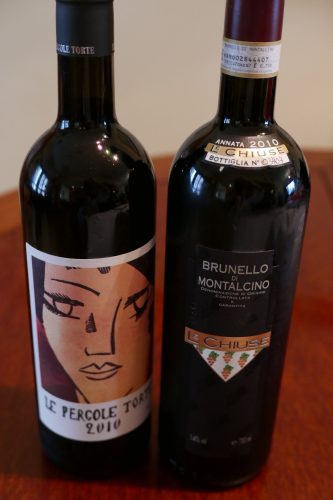 我選 Le Chiuse,是因爲他們位於 Montalcino 的北部,而 Le Pergole Torte 葡萄園也面北與東北,所以有可比性。
我選 Le Chiuse,是因爲他們位於 Montalcino 的北部,而 Le Pergole Torte 葡萄園也面北與東北,所以有可比性。
3. Montevertine, Le Pergole Torte, 2010 香氣明顯比兩個弟妹豐富,有桶香、脂粉、檀香木和香料,口感也有上佳的集中度,但丹寧略嫌突出。
與之相比,4. Le Chiuse, Brunello di Montalcino, 2010 的架構大了幾個碼,香氣更强烈,礦物味豐富,但有趣的是丹寧雖然更多,但感覺上不會太突出,原因是他有更稠密的酒體與之作平衡。
這回合殺得難分難解,由 3. Montevertine, Le Pergole Torte, 2010 以 6:5 僅勝。
第二回合的 3. Montevertine, Le Pergole Torte, 2010 變本加厲,有噴發型的香氣,檀香很迷人,但丹寧仍然凌厲。
4. Le Chiuse, Brunello di Montalcino, 2010 這時卻變得内斂,有種圓融的感覺,竟然讓我想起 Giacosa!
這回合有兩位改投了 4. Le Chiuse, Brunello di Montalcino, 2010,令他以 7:4 反超前。
很好笑的是有一位 Bur 友長嘆一聲之後投了 Le Chiuse。
座中有兩位「女人頭」鐵粉,其一改投了 Le Chiuse,因爲他發現 Le Chiuse 這時更女人頭;另一位的論點是 「女人頭」應該與其他 Chianti 相比,他說「女人頭」出類拔萃,是第一款令他對 Chianti 刮目相看的酒。
其實兩個產區的天與地都不一樣,這裏并非要比個高下。
Chianti 位於中部的山區,原來就比西部靠近海洋的 Montalcino 為冷,而且 Montevertine 更處於地勢高達 450 米左右的 Radda 小區,故此飄逸、清香是他的長處,代價是丹寧的成熟度有時會不足,越「好」的葡萄,結構便越大,平衡度也越是問題。這次的比較讓我們看得很清楚,分明弟妹比大姐好喝。正因爲丹寧的成熟度不足,Riserva 級別的 Chianti 很多時候都要用小木桶來陳釀(Le Pergole Torte 以前用 6 個月,今天用 12 個月,之後用大桶),但在 Montalcino 完全沒有此需要。因此在 Chianti,用不用小桶並不是傳統與新派的辨別依據。
接著我們試 20 嵗左右的「女人頭」,由溫暖的 2000 對濕冷的 1996。
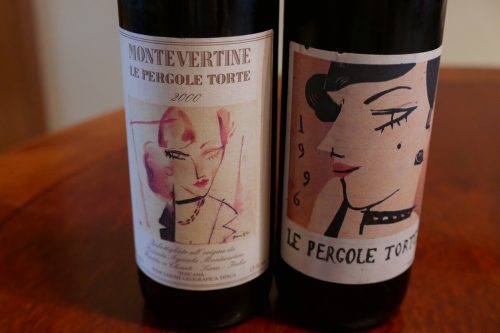 2000 有迷人的成熟香氣,年初喝過 1983 Monteverting Riserva 的朋友很開心重新遇上那漂亮的檀香,入口甜蜜,通透,很優雅!
2000 有迷人的成熟香氣,年初喝過 1983 Monteverting Riserva 的朋友很開心重新遇上那漂亮的檀香,入口甜蜜,通透,很優雅!
1996 則滿是樹皮、樹枝的香氣,帶苦又帶鹹,果味低調,有種粗獷的感覺,結構感比 2000 好。
2000 偏甜,1996 偏苦,兩者各有捧場客,所以 5. Montevertine, Le Pergole Torte, 2000 只能以 6:5 僅勝。
到了第二回合,兩者都沿著自己的路子繼續發展。2000 更檀香,但不光甜美,這時一點泥土味與礦物味為她加添了複雜性,連丹寧也出來一點了,不過依然優雅順滑,這是一種陰柔的美。
1996 仍以樹皮與樹枝爲主,但隱約也出了些檀香,比剛才多了果味,所以平衡度更佳,不過丹寧仍稍嫌粗糙,這是一種陽剛的美。
這回合讓 5. Montevertine, Le Pergole Torte, 2000 很清脆的贏了 7:4。我們兩位鐵粉第一回合都選了 1996,但此時有一位轉投 2000,因爲剛才覺得 2000 太弱,想不到在第二回合上升了;另一位卻認爲 1996 進步比較多。
最後一雙是三、四十嵗的中年婦人,年份也是一暖(1985)一冷(1980)。
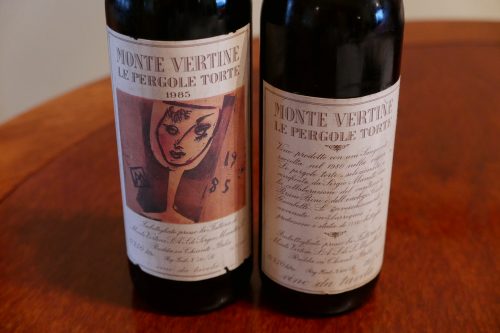 1985 的香氣開始時像 1996 與 2000 的混合體,剛冒出一點菌類香氣,但總的來説以第一級香氣爲主,但入口不太開,酸度稍欠;1980 則熟透了,帶我們進入樹林,四處都是發香的樹木和蘑菇的香氣,入口酸度好,細得幾乎感覺不出的丹寧,此乃 Chianti 最高的境界:和諧!
1985 的香氣開始時像 1996 與 2000 的混合體,剛冒出一點菌類香氣,但總的來説以第一級香氣爲主,但入口不太開,酸度稍欠;1980 則熟透了,帶我們進入樹林,四處都是發香的樹木和蘑菇的香氣,入口酸度好,細得幾乎感覺不出的丹寧,此乃 Chianti 最高的境界:和諧!
大家迷醉萬分,我們 11 個人一致認爲 87 分的 1980 年份勝過 95 分的 1985(Galloni 對年份的評分)!
第二回合的 1980 風采依然,還增加了一點集中度!此時 1985 打開一點了,酸度也上來了,有霸氣,但仍然堅硬如鐵。有人說:還沒開。我心裏卻嘀咕著:有打開的一天嗎?
不過我們有一位朋友認爲 1985 進步了,給了她同情分,令 1980 只贏了 10:1。
Wine of the Night
我讓大家為最喜歡的三款酒排了名次,用加權的方法算,名次如下:
第 1 名﹕8. Montevertine, Le Pergole Torte, 1980(29 分)
第 2 名﹕5. Montevertine, Le Pergole Torte, 2000(18 分)
第 3 名﹕6. Montevertine, Le Pergole Torte, 1996(7 分)
後記
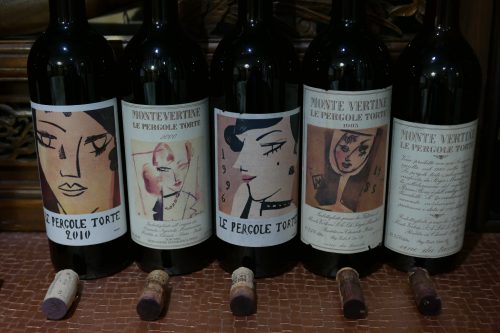 這次最令我們喝得開心的是 1980,令我思索再三的是 1985。
這次最令我們喝得開心的是 1980,令我思索再三的是 1985。
一位鐵粉總結得很好:以後找「女人頭」要找弱年份!聽說莊主最喜歡的年份也是弱年 1986 而非 1990!
我剛查過 Antonio Galloni 與 Monica Larner 的評論,他們近兩年分別參加過「女人頭」的垂直品試會,1985 的表現都非常相似,所以我那瓶并非狀態有問題。
Monica Larner 講的直白:
You are immediately aware of the wine's difficulty to achieve evolution or oxidation. It feels frozen in time, and it seems doubtful that it will ever fully open.
「女人頭」與很多 Riserva 級的 Chianti 名酒一樣,他們的名聲是建立在經典年份的龐大架構的,但如果酒始終於打不開怎麽辦?
這些大酒大多從 1980 年代才開始出現,數風流人物要看今天。凴今天的品試,酒評人豈不掉了很多眼鏡?
我一直有一個看法:Chianti 的 Riserva 特別難打開,因爲這裏的天氣較冷,丹寧不容易熟得透,所以基本版或發育不健全的 Riserva 最好喝。這次驗證了我的看法。
除了某些比較暖和的地帶,目前用葡萄質量來分級的 “Bordeaux 法”,對 Chianti 可能並不是最適當的,雖然令 Riserva 可以賣得貴一點。
最近我為另一場 Chianti 試酒會寫資料時曾有這樣的一段話:
Chianti Classico is perhaps the most misunderstood wine region in Italy, and for good reasons:
- It is huge, with 7,300 ha in production, larger than Burgundy, but there is only one appellation;
- For too long a staple food for the masses, and under the mezzadria system, grown for quantity rather than quality;
- Serious clonal studies started only in the 1980s, under the auspices of the Consorzio (Chianti 2000 Project); soil studies were also a recent phenomenon;
- Sangiovese is a very difficult grape to grow, and as a result blending was necessary, which created all sorts of problems that lasted till this day;
- It was only when outsiders bought the deserted estates after the mezzadria system broke up after WWII that money started to pour in to upgrade the game, but they were starting almost from scratch;
- There was little time to catch up when the international markets exploded, so the consultants and Robert Parkers took the lead, and the result is a standard product mix of a basic Chianti Classico, a big and often too powerful Riserva (plus a single cru for some), and a Super Tuscan with international grapes;
- In the process, has Chianti gained a market and lost its soul?
Chianti 是否贏了市場,丟失了靈魂?
這不過是我當前的猜想,一切仍待求證。
所以我要繼續上路,尋找 Chianti 真正的美。
後後記
十天後參加了莊主 Martino Manetti 主持的一場試酒會,高興的是跟他再次見面,問了他一些我一直想問的問題,失望的是大瓶裝的「女人頭」全用換瓶與雙重換瓶的方法來處理,令酒似乎失去了不少活力。
